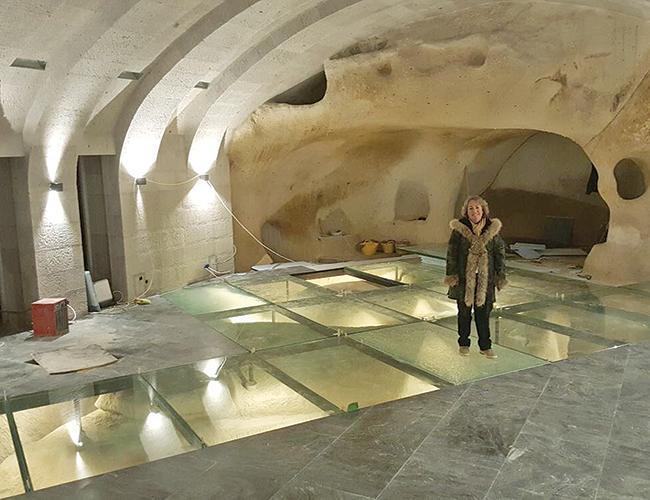
It was a photograph sent via WhatsApp that made me change my ways. I immediately diverted my route to a construction site to see the exciting finding. Within a few moments, together with the workers and the architect, we were looking down over an excavated floor that revealed an old seed press, which was until recently hidden under the debris. That might not have been so exciting for many, but I was fascinated as a former conservation architect witnessing a thrilling moment in the restoration of a historic building. It was hugely exciting as very few of the seed presses of Anatolia have managed to remain to this day.
This incident took place a few days ago in Cappadocia, where I coincidentally ran into a former colleague, Aslı Özbay, a devoted architect specialized in the restoration of historic buildings. She is just like I was 20 years ago, passionately working at building sites till midnight. She has been taking care of the ongoing restorations of Argos at Cappadocia Hotel in Uçhisar since 2010, among many other restoration works in the region. We are both graduates of the same faculty, having completed the notoriously difficult restoration masters program.
The story of the Argos restoration works goes back to 1996, when owner Gökşin Ilıcalı spent a brief holiday in the region and was struck by its beauty, eventually buying a small house for himself. He was not aware of the fact that he was embarking on a life long journey that would draw him into an obsessive passion, resulting in establishing a very special hotel and a restoration work that is now in its 21th year and set to go on for several years more.
Today, Argos in Cappadocia is a hotel that has actually a transformed complete neighborhood without losing its village feel, not fenced off from the rest of the town. That unique quality is what makes the hotel so special, within the hotel complex the village roads still wind along, with donkeys carrying loads uphill a regular feature one can see between the many rooms, lounges, terraces and gardens of the property. One article in Turkish describes it as “a hotel through which a village passes.”
Coming back to the seed press discovered, I witnessed how the unearthed and meticulously cleaned remains of the press were covered with high tech glass flooring to be viewed by the visitors, as the hall will be used as an event space. Unfortunately, seed presses no longer exist in Anatolia, but the history of oil seed plants goes back to the Hittite era of 4,000 years ago. Obtaining oil from seeds such as poppy, hemp, safflower was once very common, with the oil used primarily for lighting oil lamps, as ointment in folk medicine, or even as food. With the advance of new industrial vegetable oils like sunflower oil, the ban of hemp growing and restrictions on poppy growing, this tradition has become totally abandoned and left to the pages of history.
What thrilled me most was to witness an elusive moment where a piece of history is revealed and respectfully preserved for the future. In an age when monuments are destroyed, history is wiped out, and people are disposed, to see such a caring effort is pure excitement. Now I’m dreaming of a reconstructed seed plant in the region that will revive the seed oils of the past. After all, safflower oil is the new diet fad now, so why not rewind history back and rediscover our hidden treasures buried in history?
Fork of the Week: “Kadın Eli,” which can be literally translated as the Women’s Hand, is a kitchen restaurant and shop that offers home cooked meals and handmade foods for sale. It is joint initiative of the Argos hotel and the Uçhisar Municipality. Argos, now under the umbrella of the Doğuş Group, is keen on supporting the community and providing sustainable work opportunities for local women. Doğuş has invested 500,000 euros in the renovation work over eight months, so two buildings in a completely ruined state and their gardens were transformed to a paradise spot for village women to work and have their own financial freedom. The wafer thin flatbread the women make is phenomenal; their mixed pickles are extra crispy and electrifyingly salty-sour, just right for to brighten a meal or accompany your drinks, especially if you make a Dirty Martini.
Cork of the Week: When in Cappadocia one has to go with Emir, the local indigenous grape of the region. Emir is a lesser-known white variety of Cappadocia region, a fragile grape sensitive to high temperatures, so its picking time must be closely monitored. If the right picking time is missed, the crisp acidity unique to the grape might be lost. The greatest place to taste Emir grapes is the wine cellar of Argos in Cappadocia, converted from an old monastery chapel discovered during excavations carried out during the restoration of the hotel buildings. The atmosphere is overpowering and it is difficult to focus on the wine. But for a refreshing sip, opt for the Kocabağ Emir 2015, or for the Emir 2016 made by Corvus from the local grapes from the vineyards of the Argos hotel. The red would be the spicy Turasan Syrah 2013, again from Argos vineyards: If it satisfied the judges of the Decanted World Wine Awards - winning a silver in 2016 and a gold in 2017 - it will certainly not disappoint in Cappadocia itself.